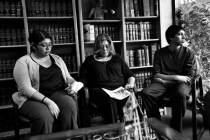Prosecutors in many American cities step in as the public’s watchdog in the aftermath of a police shooting, but the Clark County district attorney’s office is content to sit on the sidelines. It doesn’t treat shootings by police like other homicides and it won’t even review an officer’s use of deadly force unless the sheriff or a chief of police requests it.
Shootings
The wail of sirens and crack of gunshots were familiar sounds to the apartment dwellers at 2304 Tam Drive. In this area off the north end of the Strip known as the Naked City, it took more than that to get people’s attention.
In 2002, former Las Vegas police homicide Detective Dave Hatch published his first book, a how-to guide for investigating officer-involved shootings.
When North Las Vegas police shot and killed Fernando Giovanni Sauceda just nine minutes into 2011, it was the first police shooting for the department in two years.
Former University of Nevada, Reno basketball star Charles Bush had his share of problems, but until July 31, 1990, he had largely kept out of trouble with the law.
Zyber Selimaj knows his emotions tend to get the better of him. So if he had it to do over, this time he would react differently.
The Metropolitan Police Department uses deadly force at a higher rate than many other urban police agencies, according to a Review-Journal analysis
Want detailed information on how many people were shot by police in the United States last year? That’s not so easy to find.
Las Vegas police were involved in 17 shootings in 2003. Ten subjects were black, an unusually high number even for a department that historically shoots a disproportionate number of minorities. None of the officers were black.
They serve and protect. And sometimes they shoot and kill. Las Vegas Valley police have been involved in 378 shootings since 1990, 142 of them fatal. One agency alone, the Metropolitan Police Department, was responsible for 310 shootings and 115 deaths.
The homicide investigation and coroner’s inquest that followed her son’s 1999 shooting death left Connie Perrin angry and dissatisfied, so she sought emotional and financial redress in federal court.
In the wake of two controversial officer-involved shooting deaths in the summer of 2010, the Review-Journal set out to analyze two decades of shootings by officers from the Las Vegas Valley’s five major law enforcement agencies
In June 1996, Andre Rowe sat in a packed hearing room listening to testimony about the night his father was killed by Las Vegas police officer George “Gregg” Pease, who was in the position of having to explain his third fatal shooting in five years.
Police shootings make headlines. Far more common incidents when an officer would be justified in using deadly force, but elects not to, seldom get much attention.



















